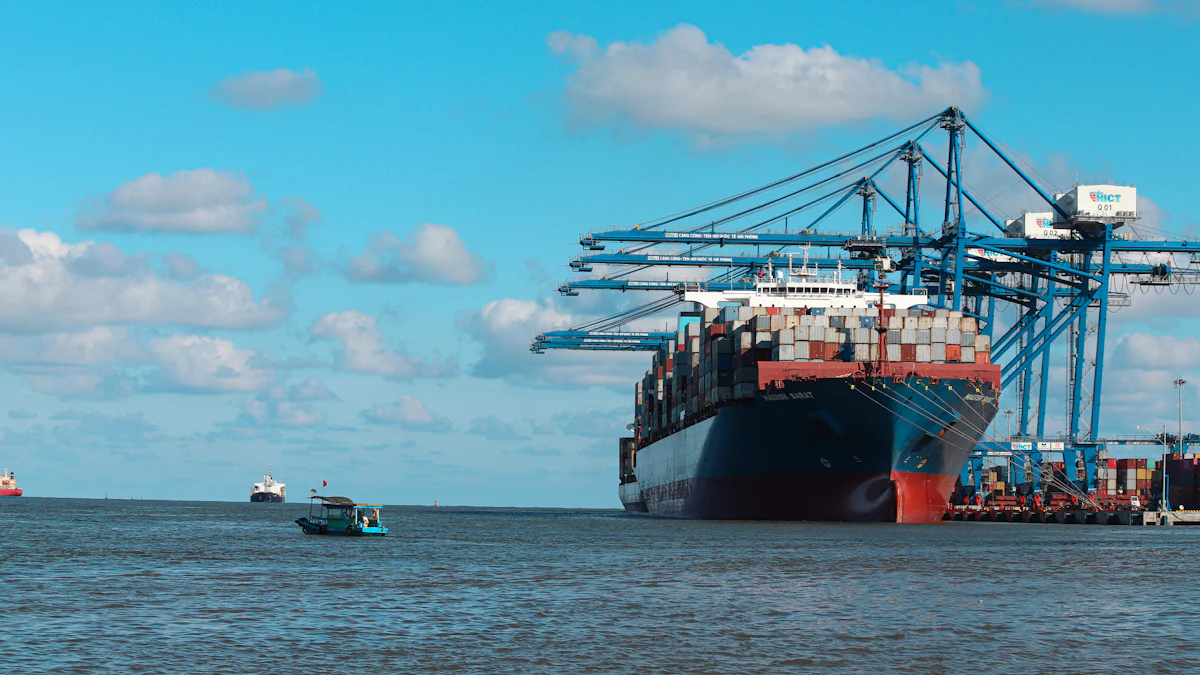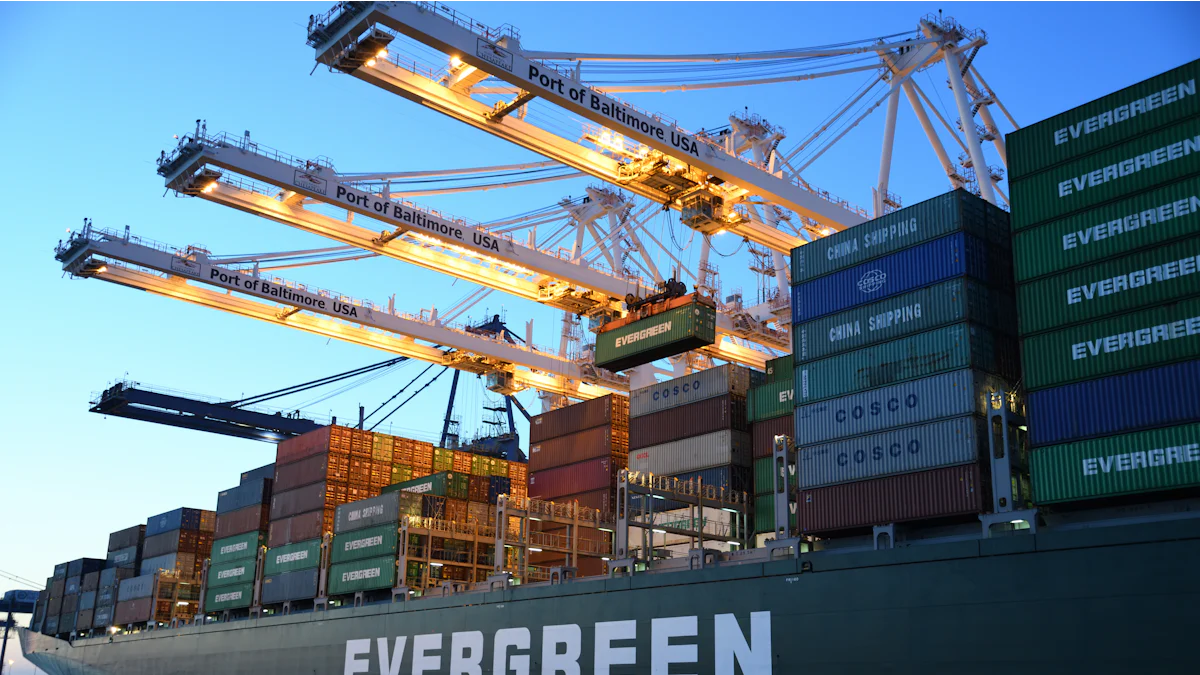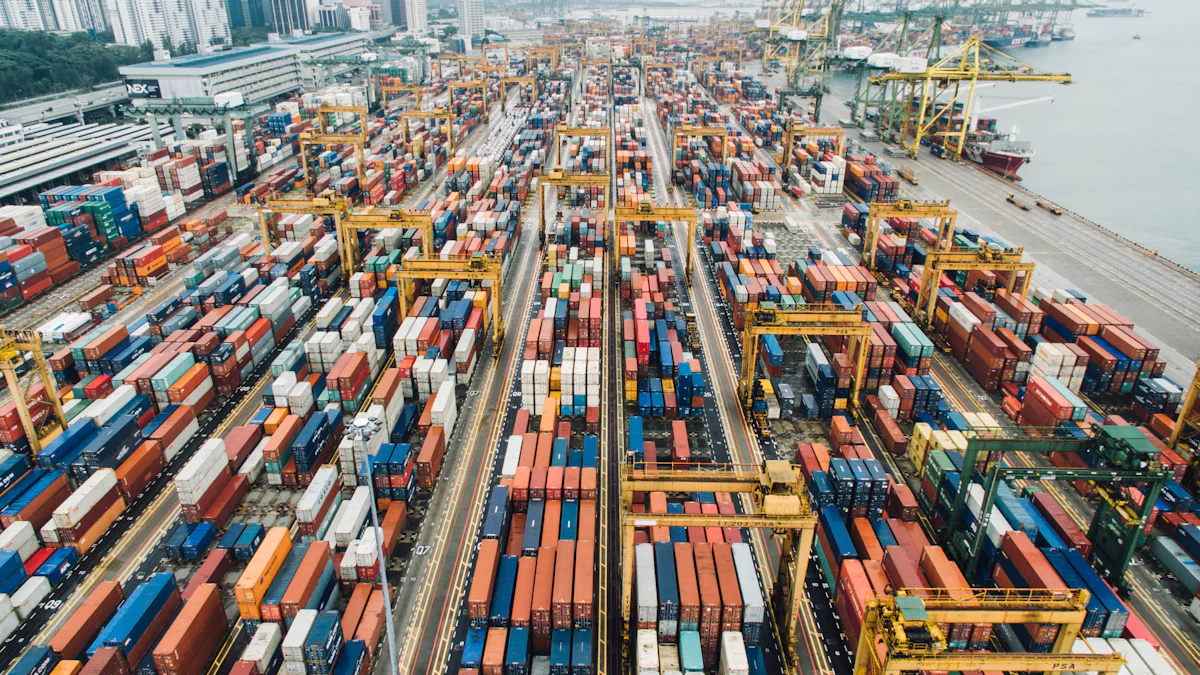Top Trends Shaping Ocean Freight Visibility in 2024

Ocean freight visibility has become a cornerstone for overcoming modern supply chain challenges. With 50% of businesses reporting no visibility into their shipments and over 20% relying on manual tracking, the need for advanced solutions has never been greater. The integration of technology is reshaping the ocean freight industry, driving efficiency and transparency. As the global ocean freight market grows, innovations in visibility tools are empowering businesses to adapt to evolving demands. These trends are not just enhancing operational reliability but also redefining how companies navigate the complexities of global trade.
AI and Machine Learning Revolutionizing Ocean Freight Visibility

Artificial intelligence (AI) and machine learning are transforming ocean logistics by introducing advanced tools that enhance efficiency and visibility. These technologies enable businesses to make informed decisions, optimize operations, and maintain a competitive edge in the global supply chain.
Predictive Analytics for Smarter Decision-Making
AI-driven predictive analytics empowers companies to anticipate potential disruptions and adjust their strategies proactively. By analyzing historical data, weather patterns, and port congestion trends, AI identifies risks and provides actionable insights. For instance, predictive models can forecast delays caused by adverse weather or high port traffic, allowing businesses to reroute shipments or adjust schedules. This capability reduces downtime and ensures smoother operations across the supply chain.
Scientific Research Findings: According to the Berkeley Center for Maritime Research, AI advancements significantly improve fleet management and predictive maintenance, enabling smarter decision-making in maritime transport.
Predictive analytics also enhances inventory management. Companies can align stock levels with demand forecasts, minimizing overstocking or stockouts. This precision not only reduces costs but also improves customer satisfaction by ensuring timely deliveries.
AI-Driven ETA Predictions and Route Optimization
Accurate estimated time of arrival (ETA) predictions are critical in ocean logistics. AI synthesizes vast amounts of data, including vessel speed, weather conditions, and port schedules, to provide precise ETAs. This accuracy helps businesses plan downstream activities, such as warehouse staffing and last-mile delivery, with greater confidence.
Scientific Research Findings: A study highlighted by Windward Blog reveals that AI-based tools enhance ETA predictions, improving operational efficiency and decision-making in ocean freight.
Route optimization is another area where AI excels. Machine learning algorithms analyze multiple variables, such as fuel consumption, shipping lanes, and geopolitical risks, to recommend the most efficient routes. This optimization reduces transit times and operational costs while minimizing environmental impact.
Real-Time Tracking Powered by Machine Learning
Real-time shipment tracking has become a standard expectation in ocean logistics. Machine learning algorithms process data from IoT devices, GPS systems, and RFID chips to provide continuous updates on container locations. This level of visibility allows businesses to monitor shipments, detect anomalies, and respond to disruptions promptly.
Scientific Research Findings: The Forbes Tech Council emphasizes that AI and blockchain technologies enhance real-time shipment tracking, offering unparalleled transparency in the shipping industry.
Smart containers equipped with sensors further enhance container tracking. These sensors monitor temperature, humidity, and movement, ensuring that goods remain in optimal conditions throughout transit. Machine learning processes this data to identify patterns and predict potential issues, such as equipment malfunctions or route deviations.
AI-based solutions like JusLink integrate these capabilities into unified platforms, offering end-to-end visibility and control. By leveraging artificial intelligence, JusLink enables businesses to streamline operations, reduce risks, and improve overall efficiency in ocean logistics.
JUSDA’s Approach to Data Standardization in Ocean Freight
JUSDA has developed a robust approach to data standardization, addressing the fragmented and unstructured nature of information in ocean freight. By leveraging its JusLink Smart Supply Chain Management Platform, JUSDA ensures seamless integration and accessibility of critical supply chain data. This approach enhances operational efficiency and fosters collaboration among stakeholders.

JUSDA Solutions
To provide you with professional solutions and quotations.
Centralizing Data for Enhanced Visibility
JUSDA prioritizes centralizing data from diverse sources, such as IoT devices, GPS systems, and customs platforms. The JusLink platform consolidates this information into a unified system, eliminating silos and ensuring consistency. This centralized structure allows businesses to access real-time insights, enabling better decision-making and proactive risk management.
Industry Insight: The Global Logistics Research Institute reports that companies adopting centralized data systems experience a 30% improvement in operational efficiency.
By standardizing data formats, JUSDA simplifies the integration of information from carriers, ports, and suppliers. This uniformity ensures that all stakeholders operate with accurate and synchronized data, reducing errors and delays in shipment tracking.
Microservices Architecture for Seamless Integration
The JusLink platform employs a microservices architecture, enabling businesses to integrate it with existing systems like ERP and TMS. This modular design allows companies to customize features based on their unique needs, ensuring compatibility across various operational environments. The architecture supports real-time data exchange, enhancing visibility and coordination throughout the supply chain.
Expert Opinion: The Maritime Technology Alliance highlights that microservices-based platforms improve scalability and adaptability in dynamic supply chain ecosystems.
This flexible framework ensures that JUSDA’s solutions remain future-proof, accommodating emerging technologies and evolving business requirements.
Driving Innovation Through Advanced Technologies
JUSDA integrates cutting-edge technologies, including AI and IoT, into its data standardization efforts. These tools process vast amounts of information, transforming raw data into actionable insights. For example, AI algorithms analyze shipping trends and port congestion patterns, providing businesses with predictive analytics to optimize operations.
The JusLink platform also incorporates intelligent risk management systems. By monitoring external factors like weather conditions and geopolitical risks, the platform delivers timely alerts, helping businesses mitigate potential disruptions. This proactive approach strengthens supply chain resilience and ensures smoother operations.
Benefits of JUSDA’s Data Standardization Strategy
JUSDA’s commitment to data standardization delivers several key benefits:
Improved Transparency: Standardized data enhances visibility across the supply chain, enabling stakeholders to monitor shipments and identify bottlenecks.
Operational Efficiency: Centralized and consistent data reduces manual handling, streamlining processes and minimizing errors.
Enhanced Collaboration: Unified data formats foster stronger partnerships among carriers, suppliers, and customers.
Scalability: The microservices architecture ensures that the platform adapts to changing business needs and technological advancements.
By implementing these strategies, JUSDA empowers businesses to navigate the complexities of global trade with confidence and precision. The JusLink platform exemplifies JUSDA’s dedication to innovation, offering a comprehensive solution for modern supply chain challenges.
Integration of Advanced Technologies for Unified Ocean Freight Platforms
The integration of advanced technologies is reshaping ocean freight platforms, creating unified systems that enhance visibility and operational efficiency. By combining artificial intelligence (AI), the Internet of Things (IoT), and blockchain, businesses can achieve end-to-end transparency and control over their supply chains.
Combining AI, IoT, and Blockchain for End-to-End Visibility
AI, IoT, and blockchain represent a powerful trio in modern logistics. Together, they enable seamless data sharing, real-time monitoring, and secure transactions across the supply chain. AI processes vast amounts of data to generate actionable insights, while IoT devices collect real-time information from shipments. Blockchain ensures that this information remains secure and tamper-proof.
For example, AI algorithms analyze shipping trends and predict potential disruptions, such as port congestion or adverse weather. IoT sensors installed on containers provide continuous updates on location, temperature, and humidity. Blockchain records these updates in an immutable ledger, ensuring transparency and trust among stakeholders.
Key Insight: The combination of these technologies reduces inefficiencies and enhances decision-making, enabling businesses to respond quickly to supply chain challenges.
This integration creates a unified platform where all participants—carriers, manufacturers, and customs agencies—can access accurate and up-to-date information. By leveraging state-of-the-art technology, companies can streamline operations and improve customer satisfaction.
The Role of IoT in Real-Time Monitoring of Shipments
IoT plays a critical role in providing real-time visibility into shipments. Sensors embedded in containers collect data on various parameters, such as location, temperature, and movement. This data is transmitted to digital platforms, allowing businesses to monitor shipments throughout their journey.
For instance, IoT devices can detect temperature fluctuations in refrigerated containers. If the temperature exceeds acceptable limits, the system sends an alert, enabling immediate corrective action. This capability is especially valuable for industries like pharmaceuticals and food, where product integrity is crucial.
Industry Insight: According to logistics experts, IoT-enabled tracking reduces shipment delays by up to 25%, improving overall supply chain efficiency.
IoT also enhances predictive maintenance. Sensors monitor the condition of shipping equipment, identifying potential issues before they escalate. This proactive approach minimizes downtime and ensures smoother operations.
Blockchain for Secure and Transparent Data Sharing
Blockchain technology addresses one of the most pressing challenges in ocean freight: secure and transparent data sharing. Traditional methods of data exchange often involve multiple intermediaries, increasing the risk of errors and delays. Blockchain eliminates these inefficiencies by creating a decentralized and tamper-proof ledger.
Each transaction or update in the supply chain is recorded as a block, which is linked to the previous one. This structure ensures that data cannot be altered without consensus from all participants. For example, blockchain can track the movement of goods from the manufacturer to the final destination, providing an unbroken chain of custody.
Key Benefit: Blockchain enhances trust among stakeholders by ensuring that all parties have access to the same accurate information.
Smart contracts further enhance the utility of blockchain. These self-executing contracts automatically trigger actions, such as payments or customs clearance, when predefined conditions are met. This automation reduces paperwork and accelerates supply chain processes.
By integrating blockchain into digital platforms, businesses can achieve greater transparency and efficiency. This technology not only secures data but also fosters collaboration among supply chain participants.
JUSDA’s Commitment to Empowering Teams in the Ocean Supply Chain
JUSDA places a strong emphasis on empowering its workforce to drive innovation and efficiency in ocean freight operations. By fostering a culture of continuous learning and collaboration, the company ensures that its teams remain equipped to meet the demands of a rapidly evolving supply chain landscape.
1. Comprehensive Training Programs for Skill Development
JUSDA invests in tailored training programs to enhance employee expertise in using advanced visibility tools. These programs focus on practical applications, such as interpreting real-time tracking data, leveraging AI-driven insights, and managing IoT-enabled devices. Employees gain hands-on experience with technologies like JusLink, enabling them to optimize operations and respond effectively to challenges.
Key Insight: Logistics experts highlight that companies prioritizing workforce training see up to a 40% improvement in operational efficiency.
Regular workshops and refresher courses ensure that employees stay updated on the latest advancements in supply chain technology. This commitment to skill development not only boosts individual performance but also strengthens the organization’s overall capabilities.
2. Promoting Collaboration Across Teams
JUSDA encourages cross-functional collaboration to bridge the gap between technology and human expertise. Teams from logistics, IT, and operations work together to customize visibility tools and align them with organizational goals. This collaborative approach fosters innovation and ensures that solutions address real-world challenges.
By integrating diverse perspectives, JUSDA creates a unified workforce capable of navigating complex supply chain scenarios. This synergy enhances decision-making and drives long-term success in digital transformation initiatives.
3. User-Centric Technology for Seamless Adoption
JUSDA prioritizes the development of user-friendly platforms to ensure seamless adoption by employees. Tools like JusLink feature intuitive interfaces that simplify navigation and reduce the learning curve. Clear dashboards and customizable features allow users to access relevant information quickly, improving productivity and confidence.
Industry Insight: Research indicates that platforms with user-centric designs achieve significantly higher adoption rates, ensuring that employees fully utilize available technologies.
This focus on usability empowers employees to harness the full potential of visibility tools, enabling them to make informed decisions and maintain operational efficiency.
4. Commitment to Sustainability and Innovation
JUSDA integrates sustainability into its operations, aligning with global environmental goals. The company equips its teams with IoT-enabled devices to monitor resource usage and minimize waste. Employees play a pivotal role in implementing eco-friendly practices, contributing to greener supply chain ecosystems.
Company Information: JUSDA’s logistics solutions promote sustainability by reducing environmental impact, reflecting its dedication to responsible business operations.
By combining innovative technologies with a skilled and engaged workforce, JUSDA ensures that its teams remain at the forefront of ocean freight transformation. This commitment to empowering employees underscores the company’s role as a leader in supply chain management.
Real-Time Information Sharing: A Growing Demand in Ocean Freight Visibility

The demand for real-time information sharing in ocean freight visibility continues to grow as businesses seek greater transparency and control over their supply chains. Advanced technologies now enable instant data exchange, improving operational efficiency and fostering collaboration among stakeholders.
Managing Disruptions with Instant Data Exchange
Instant data exchange plays a critical role in managing disruptions in ocean freight operations. Delays caused by weather, port congestion, or equipment malfunctions can significantly impact supply chains. Real-time visibility allows businesses to respond swiftly to these challenges by providing actionable insights.
For example, IoT-enabled sensors on containers transmit live updates on location, temperature, and movement. This data helps companies detect anomalies, such as route deviations or environmental changes, and take corrective actions immediately. Blockchain technology further enhances this process by ensuring secure and transparent data sharing across all parties involved.
Scientific Research Findings: According to CMR Berkeley, blockchain technology revolutionizes supply chains by enhancing security and transparency, making it easier to manage disruptions effectively.
By leveraging instant data exchange, businesses can minimize downtime, reduce financial losses, and maintain customer satisfaction. This capability ensures smoother operations even in the face of unexpected challenges.
Improving Supply Chain Agility Through Real-Time Insights
Real-time insights significantly enhance supply chain agility, enabling businesses to adapt quickly to changing conditions. Predictive analytics powered by AI processes vast amounts of data to forecast potential risks, such as port delays or adverse weather. These insights allow companies to adjust shipping schedules, reroute shipments, or allocate resources more efficiently.
IoT devices also contribute to agility by providing continuous updates on shipment status. For instance, smart containers equipped with sensors monitor cargo conditions and alert operators to potential issues. This proactive approach ensures that goods remain in optimal condition throughout transit.
Key Insight: A study published by Jusda Global highlights how automation and digitalization improve logistics performance, allowing businesses to respond dynamically to supply chain disruptions.
Real-time visibility empowers companies to make informed decisions, reducing lead times and improving overall efficiency. This agility is essential for maintaining a competitive edge in the fast-paced global market.
Collaboration Across Stakeholders for Better Visibility
Collaboration among stakeholders is vital for achieving better visibility in ocean freight operations. Carriers, manufacturers, and customs agencies must work together to ensure seamless data sharing and coordination. Unified platforms like JusLink facilitate this collaboration by integrating data from multiple sources into a single system.
Blockchain technology strengthens stakeholder collaboration by creating a decentralized ledger that records every transaction or update. This transparency builds trust among participants and eliminates inefficiencies caused by manual processes or miscommunication.
Scientific Research Findings: LinkedIn research emphasizes the value of combining blockchain with AI and IoT to enhance logistics performance and foster stronger partnerships.
By promoting collaboration, businesses can streamline operations, reduce errors, and achieve end-to-end visibility. This unified approach not only improves efficiency but also supports long-term growth and resilience in the supply chain.
JusLink’s Role in Real-Time Information Sharing
JusLink plays a pivotal role in advancing real-time information sharing within ocean freight visibility. By integrating cutting-edge technologies like AI, IoT, and blockchain, JusLink ensures businesses gain instant access to critical supply chain data. This capability empowers companies to make informed decisions, mitigate risks, and maintain operational efficiency.
1. Centralized Data for Instant Access
JusLink consolidates data from diverse sources into a unified platform. It processes information from IoT sensors, GPS systems, and blockchain networks to provide a single source of truth. This centralized approach eliminates data silos and ensures all stakeholders operate with synchronized information.
Scientific Research Findings: The CMR Berkeley study highlights that blockchain enhances transparency and security in supply chains, making it easier to manage disruptions effectively.
By offering real-time updates on shipment status, JusLink enables businesses to detect anomalies, such as route deviations or equipment malfunctions, and respond promptly. This capability minimizes delays and ensures smoother operations across the supply chain.
2. AI-Driven Insights for Proactive Management
JusLink leverages AI to analyze vast amounts of data and generate actionable insights. The platform uses predictive analytics to forecast potential risks, such as port congestion or adverse weather conditions. These insights allow businesses to adjust shipping schedules or reroute shipments proactively.
Key Insight: A report from LinkedIn emphasizes that combining AI with IoT and blockchain enhances logistics performance, enabling companies to respond dynamically to supply chain challenges.
AI also supports demand forecasting and inventory optimization. By aligning stock levels with real-time demand, JusLink helps businesses reduce costs and improve customer satisfaction.
3. IoT-Enabled Real-Time Monitoring
IoT devices integrated into JusLink provide continuous updates on shipment conditions. Sensors monitor parameters like location, temperature, and humidity, ensuring goods remain in optimal condition throughout transit. This feature is particularly valuable for industries requiring strict quality control, such as pharmaceuticals and food.
Industry Insight: Logistics experts note that IoT-enabled tracking reduces shipment delays by up to 25%, improving overall supply chain efficiency.
JusLink’s IoT capabilities also enhance predictive maintenance. By monitoring equipment conditions, the platform identifies potential issues before they escalate, reducing downtime and ensuring uninterrupted operations.
4. Blockchain for Secure Collaboration
JusLink incorporates blockchain technology to ensure secure and transparent data sharing. Each transaction or update is recorded in an immutable ledger, fostering trust among stakeholders. This transparency eliminates inefficiencies caused by manual processes or miscommunication.
Smart contracts further streamline operations by automating tasks like customs clearance or payment processing. These self-executing contracts trigger actions when predefined conditions are met, accelerating supply chain workflows.
Scientific Research Findings: The Jusda Global report highlights that blockchain revolutionizes the shipping industry by ensuring traceability and transparency in supply chains.
5. Unified Platform for Seamless Integration
JusLink’s microservices architecture allows seamless integration with existing systems like ERP, TMS, and WMS. This modular design enables businesses to customize features based on their unique needs. The platform’s scalability ensures it adapts to evolving business requirements, making it a future-proof solution.
By unifying advanced technologies, JusLink delivers end-to-end visibility and control. Its ability to centralize data, provide real-time insights, and foster collaboration positions it as an indispensable tool for modern supply chain management.
The ocean freight industry in 2024 is undergoing a remarkable transformation, driven by advancements in visibility tools and innovative technologies. These ocean freight trends, including AI-driven analytics, IoT-enabled monitoring, and blockchain integration, are reshaping the ocean supply chain by enhancing transparency and operational efficiency. Platforms like JusLink exemplify this technology transformation, offering businesses real-time insights and seamless data integration. By adopting these cutting-edge solutions, companies can streamline operations, improve decision-making, and remain resilient in an evolving global market. Embracing these innovations ensures competitiveness and long-term success.
See Also
Discovering Innovations in Sea Freight Logistics for 2024
Understanding Current Trends in Logistics Risk Management
How Enhanced Visibility Transforms Supply Chain Efficiency
Five Key Trends Shaping Future Supply Chain Efficiency
Getting Prepared: New Transport Technologies for Supply Chains
